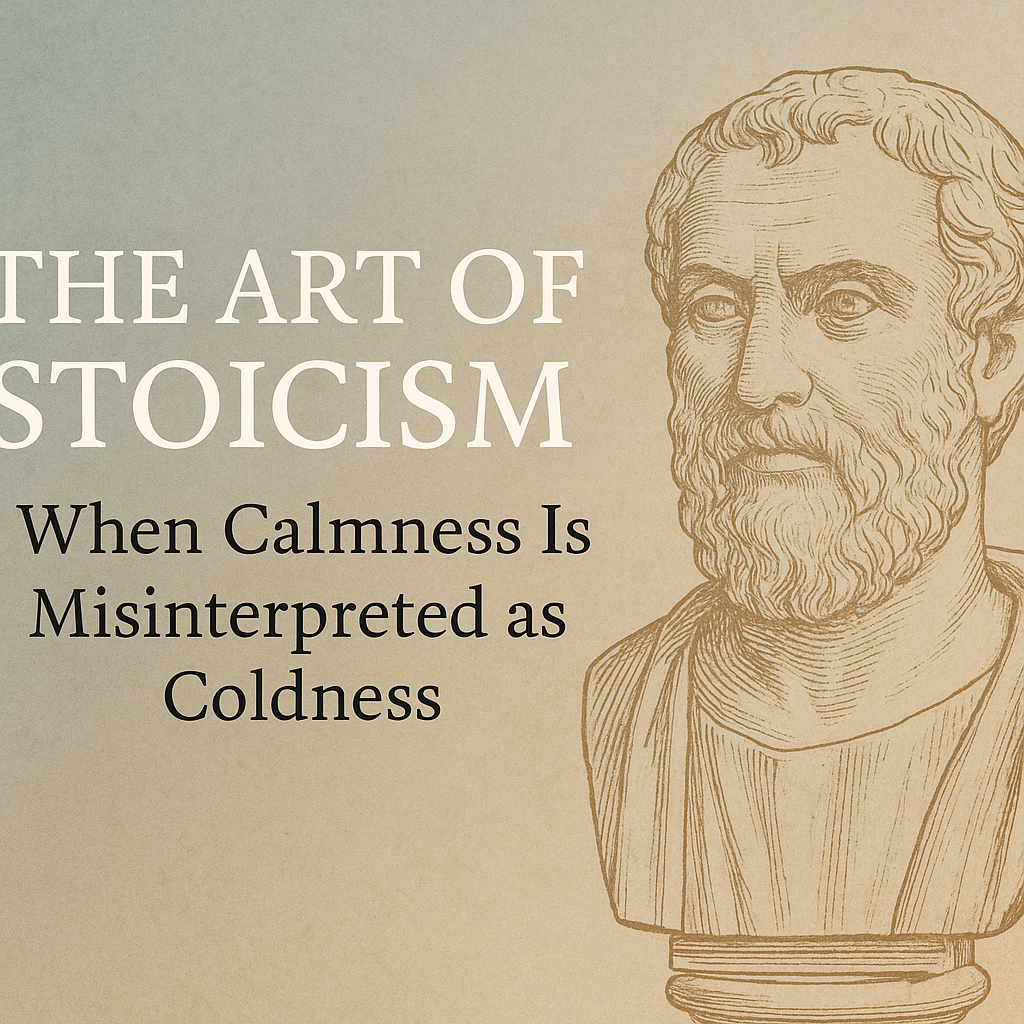The Art of Stoicism: When Calmness is Misinterpreted as Coldness

Stoicism has often been misunderstood. To some, it looks like indifference; to others, it feels like detachment. But at its heart, Stoicism is not about suppressing humanity, it is about cultivating wisdom, self-control, and resilience. In our modern world, where emotional expression is celebrated, those who practice Stoic calmness are sometimes labeled as “cold.” Yet this interpretation misses the depth and beauty of what Stoicism truly offers.
1. Stoicism: A Philosophy of Inner Strength
Stoicism is not about becoming emotionless. It is about learning to manage emotions in ways that prevent them from controlling us. Instead of reacting impulsively, the Stoic pauses, reflects, and chooses a measured response. This discipline is a sign of inner strength, not the absence of feeling.
2. The Misconception of Coldness
When someone remains calm in a heated situation, it may look like they don’t care. In reality, they may care deeply but refuse to let chaos dictate their actions. To the untrained eye, composure is mistaken for detachment, when it is really a form of discipline.
3. Self-Awareness Over Drama
Many people who seem “unmoved” are, in fact, highly self-aware. They choose peace over pointless arguments, and stability over emotional storms. What looks like coldness is often the quiet courage of someone who refuses to be pulled into unnecessary drama.
4. Introversion and the Stoic Temperament
Not all quiet people are Stoics, but many Stoics are naturally introverted. They find comfort in contemplation, reflection, and stillness rather than in grand displays of emotion. Their silence is not emptiness, it is thoughtfulness in motion.
5. When Past Hurts Shape Present Calm
A person’s demeanor often carries the weight of their history. Those who have endured heartbreak, betrayal, or trauma may develop a Stoic exterior to protect their inner world. What appears as emotional distance is sometimes a shield built out of survival.
6. First Impressions Are Deceptive
We live in a culture that prizes charm and outward expression. Yet first impressions rarely reveal the depth of a person’s character. Labeling someone as “cold” because they do not emote in expected ways often overlooks the complexity of their personality.
7. The Beauty of Silent Strength
There is quiet beauty in a person who can hold their emotions without spilling them everywhere. Stoics remind us that strength is not always loud; sometimes it is the silent presence that steadies a room in the midst of chaos.
The Narcissistic Leader Ego Drives Power and Leadership - New!
The Power of "No": Why Rejection Is a Sign You’re Headed in the Right Direction
The Power of Doing Nothing
The Powerful Truth About Being Human: What Drives Us, Divides Us, and Heals Us
The Psychology of "Us vs. Them"
8. The Difference Between Suppression and Control
Suppressing emotions can be unhealthy, but controlling them is powerful. Stoicism does not deny feelings; it acknowledges them, then channels them productively. Calmness is not numbness, it is awareness coupled with wisdom.
9. Empathy Behind the Still Face
A calm expression does not mean a lack of empathy. Many Stoic individuals feel deeply for others, but their compassion is expressed in action rather than in emotional display. They may offer stability, solutions, or presence instead of tears and dramatics.
10. Modern Society and Emotional Expectation
In today’s world, we are encouraged to “show how we feel.” While emotional openness is valuable, it also creates a bias against those who are reserved. Stoics remind us that not every emotion needs to be broadcast to be real.
11. Stoicism in Relationships
In relationships, a Stoic partner may be misunderstood as detached. But often, they are the anchor, the one who stays grounded when emotions run high. Their love is steady, reliable, and demonstrated through consistent action rather than constant verbal reassurance.
12. The Role of Perception
Coldness is often a matter of perception. What one person sees as indifference, another might recognize as composure. Perceptions shift when we learn to look deeper and understand the values guiding someone’s behavior.
13. The Stoic’s Inner World
Behind the calm exterior of a Stoic lies a rich inner world. Their thoughts run deep, their reflections are constant, and their emotions, though controlled, are profound. Calmness is not a void, it is a reservoir.
14. Learning From Stoic Calmness
Rather than misjudging calmness, we can learn from it. Stoics teach us that it is possible to face challenges without being swept away by them. They model how to stay centered even when life feels unstable.
15. Calmness as a Form of Compassion
Ultimately, Stoicism is not about detachment but about compassion, for oneself and others. By mastering calmness, Stoics avoid adding fuel to the fires of conflict. Their presence becomes a gift of peace, reminding us that strength need not roar to be real.
The art of Stoicism lies not in denying emotions but in refining them. Calmness should not be mistaken for coldness; it is often the deepest expression of strength, wisdom, and care. In a world that glorifies reaction, Stoicism invites us to pause, reflect, and act with intention. And in that stillness, we discover not the absence of humanity, but its truest form.
Suggested Readings












